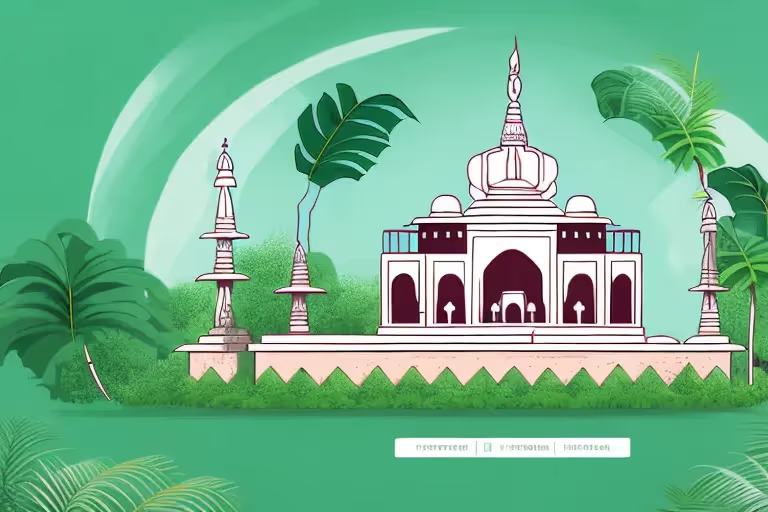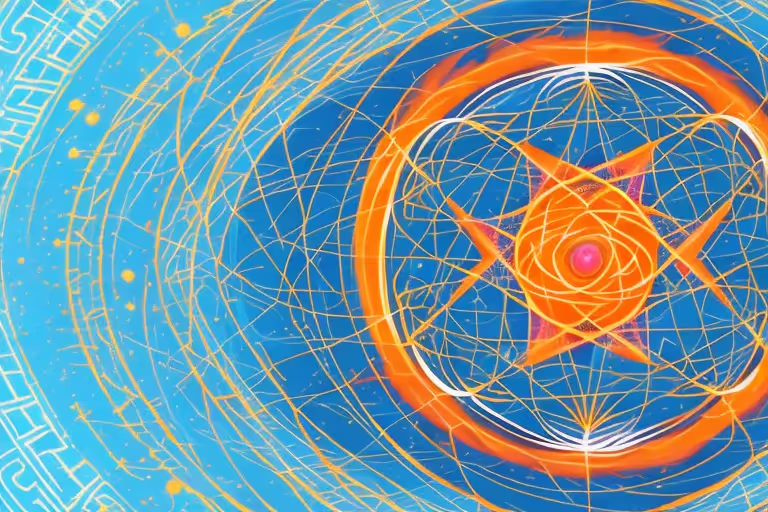Welcome to Mangalam, the ancient Indian tradition that has been passed down through generations. As you delve deeper into this world of auspiciousness and sacredness, you'll learn about the origins, philosophy, rituals, and art of Mangalam. Join me as we explore this fascinating tradition.
The Evolution of Mangalam
As time passed, Mangalam continued to evolve and adapt to the changing times. It became more than just a set of rituals and practices; it became a way of life. The philosophy of Mangalam emphasized the importance of living in harmony with nature, practicing kindness and compassion towards all living beings, and cultivating inner peace and happiness.
During the medieval period, Mangalam began to influence art and architecture. Temples and other religious structures were built with intricate carvings and designs that incorporated auspicious symbols and motifs. These structures were not just places of worship but also served as a reminder of the importance of Mangalam in daily life.
Mangalam Today
Today, Mangalam continues to be an integral part of Indian culture and society. It is practiced by millions of people all over the world, and its influence can be seen in various aspects of daily life. From weddings and other ceremonies to the design of buildings and even in the way people greet each other, the principles of Mangalam are still very much alive today.
Mangalam has also gained popularity in the West, with many people embracing its teachings and incorporating its practices into their daily lives. It has become a source of inspiration for many, offering a path towards inner peace and happiness in a world that can often be chaotic and stressful.
In Conclusion
The origins of Mangalam may be rooted in ancient times, but its teachings and principles continue to be relevant and inspiring even today. Whether you are looking for spiritual guidance, a way to live in harmony with nature, or simply a path towards greater happiness and fulfillment, Mangalam offers a wealth of wisdom and insight that can help guide you on your journey.
The Philosophy and Principles of Mangalam
The philosophy of Mangalam revolves around the concept of auspiciousness, and the principles of the five elements and their symbolism. Let's dive deeper into these ideas:
The Concept of Auspiciousness
Auspiciousness is at the heart of Mangalam. It is the belief that we can invite good fortune and blessings into our lives through specific actions, objects, and symbols. This belief is tied to the idea that every moment of our lives can be enriched with spiritual significance and assistance. By following certain rituals and practices, it is possible to align ourselves with the divine forces to increase our well-being.
For instance, in Mangalam, it is believed that starting the day with a prayer or mantra can bring positive energy and set the tone for the day ahead. Similarly, certain objects like a conch shell or a lotus flower are considered auspicious and are often used in rituals and ceremonies to attract blessings and good fortune.
Furthermore, Mangalam emphasizes the importance of gratitude and giving back. Practicing gratitude and expressing appreciation for the blessings in our lives can attract even more positivity and abundance. Similarly, giving back to the community through acts of service or charity can create a ripple effect of positivity and blessings.
The Five Elements and Their Symbolism
The five elements are earth, water, fire, air, and ether, and they play a significant role in Mangalam. Each element has its unique symbolism and is associated with specific rituals and practices.
Earth represents stability and growth, and is often associated with grounding practices like meditation and yoga. Water symbolizes purification and renewal, and is often used in rituals like bathing or pouring water on a sacred object. Fire is the transformative force, and is often used in rituals like lighting candles or incense. Air represents movement and freedom, and is often associated with practices like breathwork or pranayama. And ether is the space where all elements come together, representing the interconnectedness of all things.
By understanding and incorporating the symbolism of the elements into our daily practices, we can create a deeper connection with nature and the universe, and align ourselves with the flow of energy and abundance.
The Connection to Hinduism and Buddhism
Mangalam has connections to both Hinduism and Buddhism and incorporates certain elements of both religions. For instance, the use of mantras and the concept of karma are shared with Hinduism, while mindfulness and non-attachment come from Buddhism.
However, Mangalam also has its unique practices and beliefs, such as the emphasis on auspiciousness and the symbolism of the five elements. By drawing from multiple spiritual traditions, Mangalam offers a holistic approach to spiritual growth and well-being.
Mangalam Rituals and Practices
In Mangalam, rituals and practices are essential components. These practices help to connect with the divine and invite blessings and good fortune into our lives. Let's explore some of the most important rituals and practices of Mangalam:
The Mangala Sutra: The Sacred Thread
The Mangala Sutra is a sacred and essential thread made up of two gold pendants on a yellow thread. It's worn by married women to signify their status and to represent the bond of love and unity between a husband and wife. The Mangala Sutra is not just a piece of jewellery, but it holds a significant value in the lives of married women in Mangalam. It is a symbol of the commitment and love between a husband and wife. The Mangala Sutra is tied by the groom around the bride's neck during the wedding ceremony, and it is believed that wearing the Mangala Sutra contributes to a happy and fulfilling marriage. It is also believed that the Mangala Sutra protects the couple from negative energies and brings good fortune into their lives.
The Mangala Aarti: The Ritual of Light
The Mangala Aarti is a ritual of light that is performed to honour the divine in Mangalam. It involves lighting candles or lamps and chanting mantras to invite blessings and positive energy into our lives. The Mangala Aarti is performed every morning and evening in temples and homes across Mangalam. The light signifies the presence of the divine, and the chanting of mantras can help us connect with the divine energy. The Mangala Aarti is a beautiful and peaceful ritual that brings a sense of calm and positivity into our lives.
The Mangala Charan: The Invocation of Deities
The Mangala Charan is the invocation of deities in Mangalam. It's a practice of reciting mantras and invoking the deities to bless and protect our lives. The practice involves a symbolic offering of flowers, fruits, and sweets to the deities to show our reverence and gratitude. The Mangala Charan is performed during festivals and special occasions in temples and homes across Mangalam. This practice helps to align our energies with the divine and can bring joy, peace, and prosperity into our lives. The Mangala Charan is a beautiful and meaningful practice that reminds us of the presence of the divine in our lives.
These are just a few of the important rituals and practices in Mangalam. Each practice holds a significant value in the lives of people in Mangalam and helps to connect with the divine energy. The people of Mangalam believe that by performing these rituals and practices, they can invite blessings and good fortune into their lives and lead a happy and fulfilling life.
The Art and Architecture of Mangalam
The art and architecture of Mangalam are unique and extensive. Its influence can be seen in Indian temples, household decorations, and public spaces. Its use of sacred geometry, yantras, and symbolism helps to create a sense of sacredness and spirituality. Let's explore some of the ways in which Mangalam has influenced art and architecture:
The Influence on Indian Temple Design
Mangalam has played a vital role in Indian temple design. Its use of sacred geometry and symbolism can be seen in the intricate carvings, sculptures, and designs present in temples. It is believed that the layout of the temples is designed to reflect the universe, and each temple is built to embody a specific set of energies that invite blessings and good fortune into the lives of visitors.
The Use of Sacred Geometry and Yantras
The use of sacred geometry and yantras in Mangalam has a profound influence on art and architecture. Yantras are geometric designs that are used to represent different deities or concepts. They are believed to hold a kind of spiritual power and can help to unite us with the divine energies. They are used in the construction of temples, household decorations, and in daily practices.
The Role of Art in Mangalam Rituals
Art plays a crucial role in Mangalam rituals and practices. It is used to represent deities, affirmations, and concepts. The use of vibrant colours, intricate designs, and fine detailing helps to create a sense of the sacredness and spirituality of the tradition. Art is a beautiful and essential component of Mangalam.
The End of Our Mangalam Journey
As we come to the end of our Mangalam journey, we hope that this guide has provided a comprehensive and entertaining introduction to this ancient Indian tradition. Its belief in auspiciousness, the five elements, and the connection to Hinduism and Buddhism make it a fascinating and inclusive practice. Its rituals, practices, and art create a sense of sacredness and spirituality that can bring joy, peace, and prosperity into the lives of those who practice it. So, what are you waiting for? Join the Mangalam community and invite blessings and good fortune into your life.
Aura is Your All In One App for Meditation, Mindfulness Wellbeing
Find peace every day with one app for your whole well-being. There is no one-size-fits-all solution to mental well-being. Aura is the first all-in-one wellness app that learns how to best help you. Discover an endless library of expert-created tracks for your well-being, all taught by the world’s best coaches, therapists, and storytellers. With Aura's personalized recommendations, you can find peace every morning, day and night.



.webp)






.avif)

%20(1).avif)


.avif)
.avif)
.webp)


.avif)


















































































































.avif)

















.svg)









